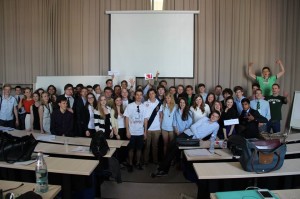Ever since its inception last year, the Lithuanian International MUN project was known for its eagerness to spread MUN culture in Lithuania (and greater region) and for its prolificacy – during its 13 months of existence, LIMUN project organized two national conferences, 3 regional conferences, an international MUN summer camp and several lectures on international politics and its whereabouts. It has never been afraid of doing MUN its own way – LIMUN project is one of the few European MUN movements that organize crises-focused conferences (rather than resolution-orientated THIMUN approach to MUN).
The first LIMUN international conference was no exception – this conference consisted only of crises-committees, all inter-linked with one another, and all discussing different aspects of one general topic – our nuclear world.
The conference was relatively small – just under 100 delegates. It was, however, highly diverse in terms of nationalities of the delegates – the conference was attended by Chileans, Latvians, Poles, Indians, and Belarusians. The conference had three interconnected committees – IAEA, DISEC, and UNSC. Each had two running topics, yet from the very first hour of committee sessions, all committees were drawn into an elaborate crises simulation.
This presented the conference staff with a unique situation: on the one hand, delegates, unaccustomed to crises simulations had a difficulty coping with some of them. Their old habits of searching for consensus and passing resolutions as soon as possible led to many crises being solved too quickly, not reaching their full potential. On the other hand, it was this precise thrill the delegates got from something so unusual, challenging, and highly involving, that made them value the conference’s program so much more.
One aspect of this crises-intensive MUN conference was the many ways the crises were presented to the delegates. Each crisis had an initial video, filmed in advance, to set the basic background for the crisis. The videos were contained usual mock news announcements, interviews with ‘representatives’ from various international organizations, but there were also videos filmed on a train (‘special on-the-spot news announcements’), on the streets of Lithuanian cities, and many other locations in Lithuania to create a strong feeling of extreme authenticity. There were, of course, the usual articles prepared for the conference specifically, guest speakers coming to committees to describe the situation, and other usual ways of coming up with the simulations.
However, two aspects of crises stood out in particular: one was the usage of real life events in the crises simulations as they happened (for example the news that Russia has been providing Syria with missiles, or that N. Korea recently tested its short-range missiles, causing concern in the South), that delegates could solve. Thus, it was not a MUN-universe that the delegates were acting in: real life events were interpreted by the delegates, which, as the delegate of India to the UNSC said after the conference ‘helped them to grow not only as MUN delegates, but also as people well versed in the affairs of the day overall’.
The second interesting idea the LIMUN staff used in their conference was to allow the delegates themselves to propose crises. To achieve that, committee discussion boards were set up on the LIMUN website, which enabled both public and private communications to go happen between delegates, which added another level of dynamism of the simulations.
In the end, DISEC had to solve crisis of escalation in illegal arms trade between China and South Africa, and Russia and Madagascar, IAEA had to decide what to do with Venezuela’s ambitions to build a nuclear power plant, and the UNSC solved crises all over the globe – from rising nationalistic sentiments in the Korean Peninsula to troubles with drones in Pakistan… The main theme of the conference – nuclear world – was not forgotten too – UNSC adopted a balanced, dialogue-seeking stance with North Korea, DISEC updated the NPT, and IAEA set new guidelines for development of nuclear energy in the developing world.

It seems that LIMUN has figured out its direction concerning the academic side of MUN. Yet, some organizational issues still need fixing. Possibly because of the lack of experienced MUNers, the chairs were sometimes struggling with engaging with the delegates, and, while the logistical side (venue, coffee breaks, accommodation) was adequate, it was not shining. That may have come from a relatively small staff – LIMUN has to expand its organizational core before they can enlarge their conferences and hope for more international recognition. However, as these problems are more circumstantial than systematic, it should not deter any prospective delegates from attending future LIMUN events.
For Europeans (and not only them!) looking for a unique, academically strong, engaging, and overall fun approach to MUN in their continent, LIMUN has a product to offer that is tough to match. As the project matures and more responsible preparation eliminates its organizational flaws, LIMUN will be definitely an attention-worth MUN movement.

